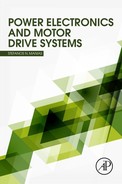6
Inverters (DC–AC Converters)
Abstract
In this chapter, state-of-the art voltage source inverters are analyzed and their possible states of operation are presented in table form; the current source inverter is analyzed as well. The most well-known pulse width modulation (PWM) control techniques are presented and analyzed including sinusoidal PWM (SPWM), multicarrier SPWM, selected harmonic PWM, trapezoidal PWM, harmonic injected PWM, hysteresis band current controlled PWM, 60°-PWM, space vector PWM. P–Q control theory, the Clarke and Park transformations are presented and the power static compensator is introduced. Solved problems and simulation results are presented to help the reader understand the theory presented in the chapter.
Keywords
60°-PWM; Alternate arm converter (AAC); Cascaded H-Bridge multilevel inverter (CHBMI); Clarke and Park transformations; Current source inverter (CSI); dc–ac power conversion; Director switch; Equivalent circuit; Flying capacitors multilevel inverter (FCMI); H-bridge; Half-bridge; Harmonic injected PWM (HIPWM); Hysteresis band current controlled PWM (HBCC-PWM); Inverter; Modular multilevel converter (MMC or M2C); Multicarrier SPWM (MCSPWM); Multilevel inverter; Neutral point diode clamped multilevel inverter (NPDCMI); P–Q control; Power transfer; Pulse width modulation (PWM); Selected harmonic PWM (SHE-PWM); Simulation; Sinusoidal PWM (SPWM); Space vector PWM (SVPWM); Switching states; Three-level inverter; Trapezoidal PWM (TPWM); Two-level inverter; Voltage source inverter (VSI)
6.0. Introduction
Inverters are power electronics converters which convert a dc voltage or current source to a single-phase or three-phase ac voltage or ac current with variable amplitude and/or variable frequency. Inverters are used in the following applications:
• ac motor drive systems
• Electric power transmission systems
• Renewable energy sources (RES)
• Active filters used for harmonic suppression and electric power quality improvement
• Active power factor correction systems
• Uninterruptible power supply (UPS) systems
Inverters depending on their type of input source are categorized as:
a) Voltage source inverters (VSI)
b) Current source inverters (CSI)
Furthermore, they can be subdivided as:
i) Single-phase half-bridge inverters
ii) Single-phase full-bridge or H-bridge inverters
iii) Three-phase full-bridge inverters
Fig. 6.1 shows the various topologies of two-level inverters, which are used today in the applications mentioned above. They are called two-level because their output phase voltages, as will be shown later on, are synthesized using only two different voltage values Vin/2 and −Vin/2. In this chapter, various topologies of inverters will be presented and analyzed under ideal operating conditions.
..................Content has been hidden....................
You can't read the all page of ebook, please click here login for view all page.
